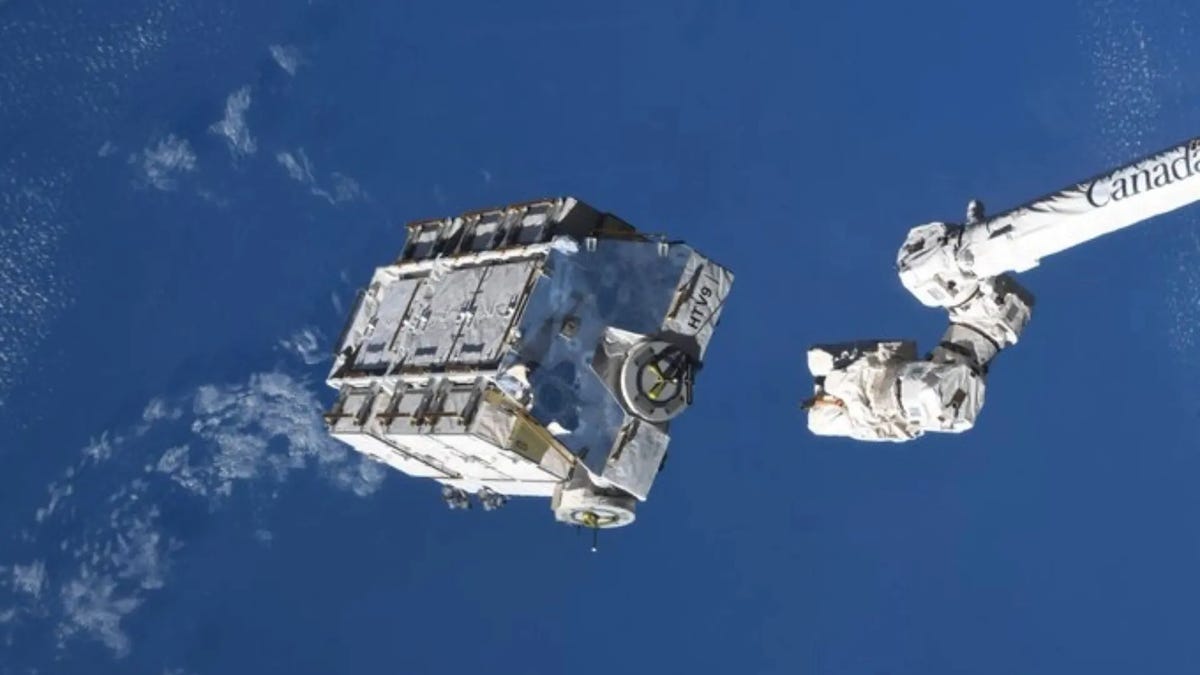
On March 8, a small, cylinder-shaped object fell from the skies and crashed through the roof of a family home in Naples, Florida. Alejandro Otero, the homeowner, suspected it came from space but he wasn’t sure what he needed to do get NASA’s attention and be taken seriously.
“I’ve left messages and emails without a response,” Otero wrote on X. Eventually, the space agency heard that a piece of its trash may have fallen on a Florida home and retrieved the object for analysis. The time and place of reentry, however, coincided with the reentry of a 2.9 ton pallet containing discarded batteries from the International Space Station.
Advertisement
If it weren’t for Otero being vocal online and reaching out to media outlets, that small fragment of the space station trash may have still been sitting on his broken floors.
Advertisement
Who you gonna call?
The chances of getting hit by space junk are slim, but they’re not zero. On average, 200 to 400 human-built objects reenter through Earth’s atmosphere every year, and, if you’re very unlucky, fragments from those objects could survive the heat of the trip and land on or near you. However, there are no clear guidelines to follow should space junk end up on your property.
Advertisement
“Who do you call, right?” Jonathan McDowell, an astrophysicist at the Harvard–Smithsonian Center, who tracks atmospheric reentries, told Gizmodo. McDowell was contacted by Florida homeowner Otero on X, and in turn helped him get in touch with someone at The Aerospace Corporation, a non-profit research and development center.
Advertisement
“There is no standard protocol to report suspected space debris,” The Aerospace Corporation told Gizmodo in an emailed statement. “Aerospace has, on several occasions, been asked to forward information to the appropriate government organization, as was the case here.”
NASA and the U.S. Space Force’s Space Systems Command are the most common U.S. organizations that handle these events, the statement added.
Advertisement
The Aerospace Corporation investigates reentry debris and, according to McDowell, “know what they’re doing.” And because “they’re a small enough organization, that query won’t get lost, unlike at NASA,” he added. Therefore, that would be a good place to start.
NASA does have its own office that focuses on mitigating the risk of debris. The Orbital Debris Program Office at the Johnson Space Center measures near-Earth orbital debris with ground based radars and optical telescopes, and also collects spacecraft that have returned to Earth, to assess the risk posed to other spacecraft, as well as to humans on the ground.
Advertisement
Finder’s keepers doesn’t apply
Of course, just because the space trash landed on your property doesn’t make it yours. As the 1967 Outer Space Treaty dictates, the ownership of space objects does not change regardless of whether they are in outer space or on Earth. So once you make that call, be ready to give up the goods.
Advertisement
It’s probably not a good idea to hold onto space debris either way as it could contain hazardous material, so it’s best not to get too chummy with the mysterious object that fell from the sky.
Still, don’t expect the owner of the space debris to be too happy about claiming it as it could mean they are liable for damage. In 1983, the Canadian government billed the Soviet Union for damage from its nuclear-powered satellite, which malfunctioned and came tumbling down in an uncontrolled reentry, scattering radioactive debris over northern Canada. The USSR ended up paying $3 million Canadian, or about half of what Canada had asked for in compensation.
Advertisement
Who pays for damages?
The 1972 Liability Convention states that the launching country is liable to pay compensation for any damage caused by its space object, whether in orbit or on Earth. However, the convention stipulates that a company or institution is only liable for its space debris if it was negligent in some way, but it fails to define what would constitute as negligence in that case.
Advertisement
In the case of Otero, for example, the Florida homeowner might be seeking compensation from NASA for the damage done to his home. In response to Gizmodo’s request for comment, Otero’s lawyer reached out on his behalf and stated that there is a pending claim.
In terms of who’s liable in that case, that’s up for question since the batteries were launched to the space station by the Japanese space agency JAXA. It’s not immediately clear who should be responsible for the potential damage caused by the space debris.
Advertisement
It’s worth noting that the only person in the world to be hit by space junk, Lottie Williams, was not compensated for the incident that took place in 1997. That might just be a sign of the times, though.
Related article: Deaths From Falling Rocket Debris Are Highly Unlikely—but That’s Changing
“As space activity increases, you worry that you’re going to see more of this,” McDowell said. “On the other hand, people are getting more conservative about letting big things like [the ISS pallet] reenter. I would say it’s an ongoing risk, but I’m hoping that we won’t see a big increase in it, even as activity ramps up,” he added.
Advertisement
As the space industry continues to grow, so too does the number of objects in the sky. Scientists currently estimate that the odds of being hit by a piece of falling space junk are around one in a trillion, but are those odds at risk of changing? A study from 2022 predicted a 10% chance of one or more casualties from falling rocket parts in the next decade. Otero and his son came frighteningly close to turning this prediction into reality.
For more spaceflight in your life, follow us on X and bookmark Gizmodo’s dedicated Spaceflight page.
Services Marketplace – Listings, Bookings & Reviews